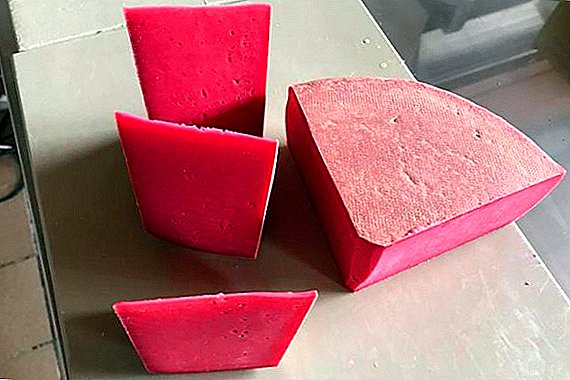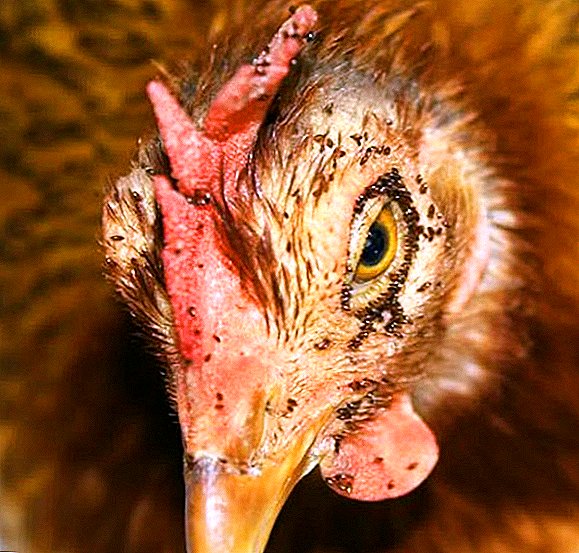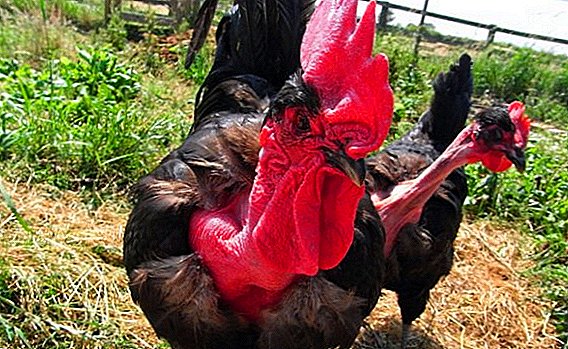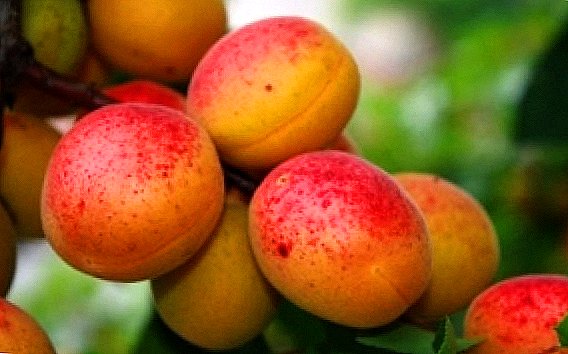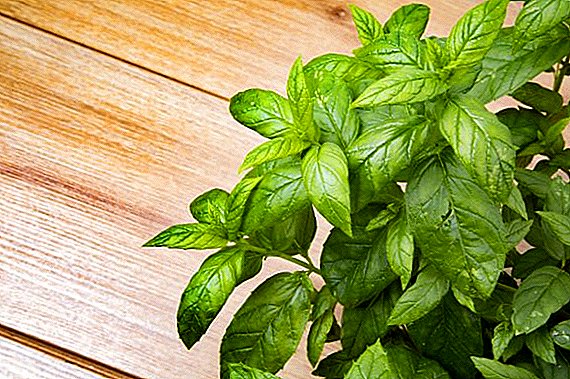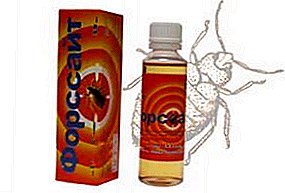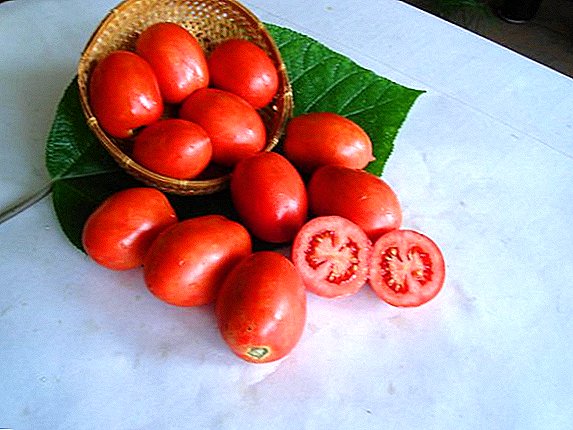 Tomatoes - It is always a good solution for gardeners. It is very simple to grow them in your plot, and there is a lot of benefit from them. In addition to its nutritional value, tomatoes are rich in vitamins and nutrients, and they can decorate any dish. In order for us to enjoy this wonderful vegetable, breeders have deduced many early varieties, and among them Tomatoes varieties Shuttle, which are increasingly found in the garden. In more detail about a grade of a tomato the Shuttle, about that how to grow up these tomatoes independently, this article will tell.
Tomatoes - It is always a good solution for gardeners. It is very simple to grow them in your plot, and there is a lot of benefit from them. In addition to its nutritional value, tomatoes are rich in vitamins and nutrients, and they can decorate any dish. In order for us to enjoy this wonderful vegetable, breeders have deduced many early varieties, and among them Tomatoes varieties Shuttle, which are increasingly found in the garden. In more detail about a grade of a tomato the Shuttle, about that how to grow up these tomatoes independently, this article will tell.
Tomato Shuttle: Description
Tomato variety Shuttle - early ripe tomatoes, which even an inexperienced farmer can cope with growing, because these vegetables are primarily distinguished by unpretentiousness to growing conditions and care. Tomatoes Shuttle have a rather attractive characteristic for gardeners: a plant of this variety is a standard bush with a height from 45 to 55 cm.
Did you know? Tomatoes Shuttle - deterministic variety with limited growth.
 Fruits are juicy and fleshy, oval-shaped, with a convex tip. The skin of the fruit is glossy, saturated red and quite dense. On average, the weight of the fruit reaches from 45 to 60 g. Variety of tomato Shuttle has a fairly high yield: from 5 to 8 kg of fruits can be collected from one square meter of land. Bushes fructify already in 80-120 days after emergence of shoots.
Fruits are juicy and fleshy, oval-shaped, with a convex tip. The skin of the fruit is glossy, saturated red and quite dense. On average, the weight of the fruit reaches from 45 to 60 g. Variety of tomato Shuttle has a fairly high yield: from 5 to 8 kg of fruits can be collected from one square meter of land. Bushes fructify already in 80-120 days after emergence of shoots.
Tomato growing Shuttle: conditions for planting
Tomatoes Shuttle do not require special care, but it is better to create certain conditions for the plant, and first of all it concerns the place for planting.
Where to put Shuttle
Most often, the tomatoes of the Shuttle variety are grown with seedlings, but in some regions this plant can be planted directly on the garden bed. In either case, the place for cultivation should be well lit and with good ventilation, but it is better to place containers with seedlings or bushes in open ground away from drafts. The best predecessors for tomatoes Shuttle will be zucchini, cucumbers, carrots, cabbage, dill or parsley.
Important! It is better not to plant the Shuttle next to eggplants, potatoes and peppers.
What kind of ground does Shuttle need for successful growth?
 If you have already decided to acquire Shuttle variety tomatoes, then it is better to choose a substrate with a good composition for cultivation. A highly nutritious loose drained soil is best for this, for good access of water and oxygen to the roots; pH of the soil is 5.5-6.0. It is best to mix 2 parts of humus and 1 part of chernozem, you can also add 1 part of sand and some vermiculite to the soil.
If you have already decided to acquire Shuttle variety tomatoes, then it is better to choose a substrate with a good composition for cultivation. A highly nutritious loose drained soil is best for this, for good access of water and oxygen to the roots; pH of the soil is 5.5-6.0. It is best to mix 2 parts of humus and 1 part of chernozem, you can also add 1 part of sand and some vermiculite to the soil.
Sowing Shuttle to seedlings
Tomatoes Shuttle is most often grown by means of seedlings.
Tomato Shuttle: timing, preparation of seed, the choice of capacity for planting
Before sowing tomato seeds Shuttle, it is necessary to carry out some preparatory work. The seeds do not require special preparation: they are sufficiently disinfected in a solution of water and hydrogen peroxide in a ratio of 3 ml of peroxide per 100 ml of water. This mixture should be heated to 40 degrees and keep the seeds in it for 10 minutes. In order to germinate the seeds, you can use a cloth: you need to wet it and put the seeds in it so that they do not touch each other. Seeds, wrapped in cloth, should be placed in a plastic container and covered with a film.
Did you know? Cover the film completely impossible, you need to leave a small hole for access of air.
 The film must be completely removed several times a day for airing. Seeds germinate rather quickly and in a couple of days they are ready for sowing. Capacity for sowing can be chosen to your liking, for this purpose, suitable and peat, and paper, and plastic cups or a cassette. Even if the container is new, it must be disinfected: soak in a strong solution of potassium permanganate for half an hour. It is best to sow the seedlings at the end of February, then already at the end of May - beginning of June you will be able to please the family with homemade tomatoes.
The film must be completely removed several times a day for airing. Seeds germinate rather quickly and in a couple of days they are ready for sowing. Capacity for sowing can be chosen to your liking, for this purpose, suitable and peat, and paper, and plastic cups or a cassette. Even if the container is new, it must be disinfected: soak in a strong solution of potassium permanganate for half an hour. It is best to sow the seedlings at the end of February, then already at the end of May - beginning of June you will be able to please the family with homemade tomatoes.
Sowing scheme
The landing scheme is quite simple: if you grow each seedling bush in a separate container, then in one container you need to sow 2-3 seeds to a depth of 0.5-1 cm, and if in a large total capacity, then you need to sow the seeds in the prepared moist soil, make furrows in it , 1-2 cm deep at a distance of 5-7 cm. Seed need to depth 1-1,5 cm
How to care for seedlings Shuttle
The first thing to do is to constantly air the seedlings and moisten the soil at the first sign of drying of the substrate. Do it better with a spray gun. Contain boxes with seedlings need at a temperature of 22-24 ° C. As soon as the first shoots appear, you need to move the containers with seedlings to a cooler place and remove the film. During the week, the temperature should be around 16 ° C during the day and 13 ° C at night. After seven days, the temperature was again raised to 19 ° C. Watering should be moderately defended or rain water with a temperature of about 19 ° C.
Important! As soon as the cotyledon leaf reaches 0.5 cm in length, the plant can be dived.
 Experts recommend additional coverage of seedlings, for this you can use a fluorescent lamp. Fertilizing should be carried out depending on the state of the plant, you can fertilize the seedlings "Nitrofoskoy" or "Crystal". For the first time, the plant is fed 10-12 days after the pick.
Experts recommend additional coverage of seedlings, for this you can use a fluorescent lamp. Fertilizing should be carried out depending on the state of the plant, you can fertilize the seedlings "Nitrofoskoy" or "Crystal". For the first time, the plant is fed 10-12 days after the pick.
Planting seedlings in open ground
Before planting the seedlings in open ground, it must be hardened: when the temperature reaches 8-10 ° C, take it to the balcony or to the veranda for an hour and a half. To put tomatoes on a permanent place Shuttle can, when the temperature of the soil reaches 12 ° C. Before planting tomatoes, it is necessary to water the soil thoroughly and abundantly so that the earth “sticks together” around the roots and does not crumble.
The depth of planting should be equal to the height of the tank in which the seedlings were grown. It is better to plant seedlings in the afternoon, in cloudy weather. For Shuttleman, the distance between the rows should be at least 30-35 cm. Next to the planted bushes you need to drive a stake, to which you will later tie up tomatoes.
Growing a tomato Shuttle: how to care for a plant
Tomatoes Shuttle do not require much effort in growing. It is enough from time to time to water and feed the plant, and also not to forget about weeding and timely examination for the presence of diseases and pests.
How to water the plant
 Tomatoes - It is the vegetable crop that tolerates drought well, but the yield of tomatoes, while following the rules of irrigation, increases significantly. It is especially important to observe the measures of irrigation immediately after transplanting into open ground. The more carefully you water the plant, the faster it will take root. Also, special attention to watering tomatoes should be paid during the formation of the ovary of the fruit, otherwise the flowers and ovaries just fall off.
Tomatoes - It is the vegetable crop that tolerates drought well, but the yield of tomatoes, while following the rules of irrigation, increases significantly. It is especially important to observe the measures of irrigation immediately after transplanting into open ground. The more carefully you water the plant, the faster it will take root. Also, special attention to watering tomatoes should be paid during the formation of the ovary of the fruit, otherwise the flowers and ovaries just fall off.
During ripening, it is important not to over-flow tomatoes, because excessive moisture will cause the amount of dry matter in the tomato to fall, and they will crack or rot. The depth of soil moistening also depends on the growth period, for example, during the period from planting seedlings to the formation of ovaries, watering should be done in such a way that the soil was wetted to a depth of 20-25 cm, but during fruit ripening - 25-30 cm . Watering tomatoes Shuttle need every 7-10 days at the rate of 30 liters of water per 1 square meter.
Top dressing of tomatoes
 In order to increase the yield of tomatoes, as well as to strengthen the plant, tomatoes need to be fed. The first feeding is carried out 12 days after planting the seedlings. Then you need to feed the plant every 7-10 days, using both mineral and organic fertilizers. For one plant you need to use 0.5-1 liter of fertilizer.
In order to increase the yield of tomatoes, as well as to strengthen the plant, tomatoes need to be fed. The first feeding is carried out 12 days after planting the seedlings. Then you need to feed the plant every 7-10 days, using both mineral and organic fertilizers. For one plant you need to use 0.5-1 liter of fertilizer.
Did you know? In order for the fruit to start well during budding and flowering, you can spray the plants with a solution of Epin in the ratio of 2 drops per 200 ml of water.
Also, as a preventive measure, foliar nutrition can be carried out with boric acid, which will make the plant more resistant to bad weather conditions. For replacement of boric acid suitable biostimulator "Ovary".
Major pests and plant diseases
Despite the fact that the Shuttle - the plant is quite resistant and tolerates even the most adverse weather conditions, from time to time and this variety can be damaged by diseases and pests. Among the most common diseases of tomatoes, gardeners often have to face blight, which affects the whole plant and is accompanied by the appearance of brown spots on the trunk, leaves and the fruit itself. 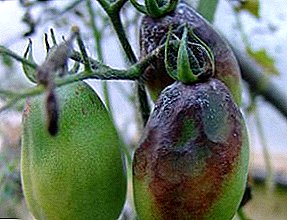 Another rather dangerous disease is tomato anthracnose, the consequences of which are black spots throughout the plant, but most often on unripe fruits. The most common disease in almost all vegetable and fruit crops is powdery mildew, which manifests itself as white spots on the leaves of the bush. It is necessary to protect the plant from diseases with the help of fungicides, as well as to constantly weed the plants, because most of the diseases live in dead leaves and weeds.
Another rather dangerous disease is tomato anthracnose, the consequences of which are black spots throughout the plant, but most often on unripe fruits. The most common disease in almost all vegetable and fruit crops is powdery mildew, which manifests itself as white spots on the leaves of the bush. It is necessary to protect the plant from diseases with the help of fungicides, as well as to constantly weed the plants, because most of the diseases live in dead leaves and weeds.
As for pests, most often the tomatoes of the Shuttle are attacked by a bear, a melon-growing aphid, gall nematodes, spider mites, as well as the common Colorado potato beetle. It is necessary to fight pests by means of insecticides, and also it is possible to carry out spraying with a soap solution.
Shuttle Harvesting
Tomato harvest Shuttle can be already in 3-3.5 months after transplanting in open ground.
Important! Harvesting tomatoes of this variety can be quite a long time, almost the entire season.
 You can even collect tomatoes immature, put them on a sunny place and, turning, let them dospet. It is important that the tomatoes do not overslept, and if it has already happened and the fruits have lost elasticity, they should be immediately processed or consumed. The best condition for harvesting is still hard fruit, then the fruits will lie longer.
You can even collect tomatoes immature, put them on a sunny place and, turning, let them dospet. It is important that the tomatoes do not overslept, and if it has already happened and the fruits have lost elasticity, they should be immediately processed or consumed. The best condition for harvesting is still hard fruit, then the fruits will lie longer.
Tomato Shuttle: pros and cons of variety
Tomatoes varieties Shuttle - A good option for those who almost simultaneously with the melting of snow loves fresh vegetables from the garden. Of course, the early ripeness of these tomatoes is a definite plus of this variety. Another important advantage of Shuttle is that these fruits can be kept fresh for a long time, and also due to their small size they can be easily preserved even in small containers. The advantages of Shuttle include the fact that growing tomatoes of this variety is quite easy, and they do not require particularly favorable conditions.
According to gardeners, Shuttle has only two minuses: not too rich aroma and taste. As you can see, growing a Shuttle variety tomato is a fairly simple process, and if you try a little more than is required, then the plant will delight you with a better crop.


